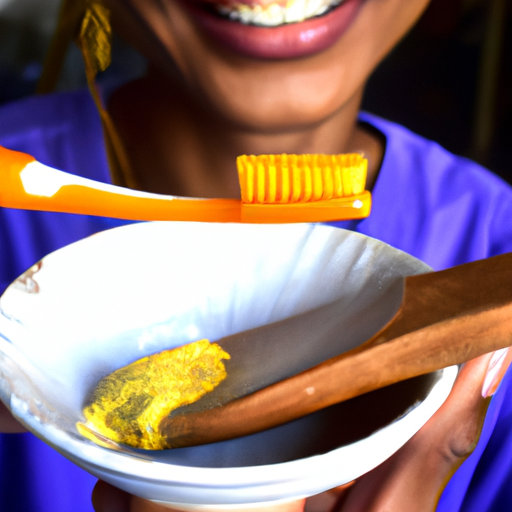I have always been interested in natural teeth-whitening methods because I value a bright, healthy smile. So, when I heard about the potential benefits of using turmeric and coconut oil to whiten teeth, I was intrigued.
These two ingredients have been hailed for their numerous health benefits, but can they really work together to whiten teeth naturally? Teeth discoloration is a common issue that affects many people, and there are various causes of it. Factors like age, genetics, poor dental hygiene, certain medications, and consuming certain foods and drinks can all contribute to yellow or stained teeth.
While there are many conventional teeth-whitening products available, some of them can be harsh and damaging to the teeth and gums. So, could natural remedies like turmeric and coconut oil be a safer and more effective alternative? In this article, we’ll explore the science behind these ingredients, the pros and cons of using them for teeth whitening, and how to use them properly.
Key Takeaways
- Turmeric and coconut oil are natural teeth whitening remedies that can be used together for more effective whitening.
- Turmeric contains curcumin which improves gum health and reduces plaque buildup, while coconut oil has antimicrobial properties that kill harmful bacteria in the mouth.
- Natural teeth whitening methods may take longer but provide long-term benefits with minimal risks and long-term effects.
- Prioritize the health and safety of teeth when considering teeth whitening methods and consult with a dentist before trying any at-home teeth whitening methods.
What Causes Teeth Discoloration
It’s important to understand what causes teeth discoloration before trying remedies like turmeric and coconut oil.
Teeth can become yellow or stained due to a variety of factors, including poor oral hygiene, aging, certain medications, and consuming dark-colored foods and drinks such as coffee, tea, and red wine. Smoking and tobacco use can also cause teeth discoloration.
Prevention is key when it comes to teeth discoloration. Regular brushing, flossing, and dental cleanings can help remove surface stains and prevent plaque buildup. Cutting down on dark-colored foods and drinks and quitting smoking can also prevent further discoloration.
By understanding the causes of teeth discoloration and taking preventative measures, individuals can maintain a brighter, healthier smile. Moving forward, it’s important to consider the potential dangers of conventional teeth-whitening products.
What are the Dangers of Conventional Teeth-Whitening Products
You may not realize the potential risks associated with using traditional teeth-whitening products. While they may promise a brighter smile, these products often come with chemical risks and health concerns.
For example, many teeth-whitening products contain hydrogen peroxide, a bleaching agent that can cause tooth sensitivity and gum irritation. Additionally, overuse of these products can lead to damage of tooth enamel, which is essential for protecting teeth from decay and cavities.
Finally, the environmental impact and sustainability of these products should also be considered, as they often come in plastic packaging and their production can have harmful effects on the environment.
It’s important to be aware of these risks and to consider alternative methods for teeth whitening. In the next section, we’ll explore the science behind turmeric and coconut oil and how they can be used as natural and safe alternatives to conventional teeth-whitening products.
The Science behind Turmeric and Coconut Oil
Now, if you’re looking for a natural and safe way to brighten your smile, let’s explore the fascinating science behind using the dynamic duo of turmeric and coconut oil, which could be the silver lining you’ve been searching for.
Turmeric has been used for centuries as a natural remedy for a variety of health issues, including inflammation and digestive problems. It contains a powerful compound called curcumin, which has anti-inflammatory and antioxidant properties that can help improve gum health and reduce plaque buildup.
Coconut oil, on the other hand, is high in lauric acid, which has antimicrobial properties that can help kill harmful bacteria in the mouth. When combined with turmeric, coconut oil can help enhance the absorption of curcumin, allowing it to penetrate deeper into the teeth and provide more effective whitening. In addition, coconut oil helps nourish and moisturize the gums, promoting overall oral health.
Overall, the science behind turmeric and coconut oil benefits for teeth whitening is promising, and it’s worth considering as an alternative to conventional teeth whitening products.
Now, let’s discuss the pros and cons of using turmeric and coconut oil for teeth whitening, so you can make an informed decision about whether this natural method is right for you.
The Pros and Cons of Using Turmeric and Coconut Oil for Teeth Whitening
If you’re searching for a natural way to brighten your smile, it’s important to weigh the pros and cons of using turmeric and coconut oil for teeth whitening. On the plus side, both turmeric and coconut oil have been shown to have teeth-whitening properties.
Turmeric contains a compound called curcumin, which has anti-inflammatory and antioxidant properties that can help remove surface stains on teeth. Coconut oil, on the other hand, has antibacterial properties that can help reduce plaque buildup and prevent tooth decay.
However, it’s important to note that using turmeric and coconut oil for teeth whitening may not be as effective as other whitening methods, such as professional teeth whitening or over-the-counter whitening strips. In addition, there are some safety concerns to consider.
Turmeric can stain clothing and other surfaces, so it’s important to be careful when using it. Coconut oil is generally safe to use, but some people may experience allergic reactions or skin irritation. Overall, while turmeric and coconut oil may offer some benefits for teeth whitening, it’s important to consult with a dentist and weigh the potential risks and benefits before trying this method yourself.
When it comes to using turmeric and coconut oil for teeth whitening, there are a few things to keep in mind. First, it’s important to use a high-quality, food-grade turmeric powder to avoid any potential contaminants. Second, mix the turmeric powder with coconut oil to create a paste, and gently brush the mixture onto your teeth for a few minutes. Finally, rinse your mouth thoroughly with water and brush your teeth as usual.
While this method may not be as effective as other whitening methods, it can offer a natural and safe way to brighten your smile.
How to Use Turmeric and Coconut Oil for Teeth Whitening
When it comes to using turmeric and coconut oil for teeth whitening, there are a few different methods of application that you can try.
From making a paste to using a mouthwash, the options are varied and can cater to your specific needs.
However, it’s important to use these ingredients safely and effectively, so here are some tips to keep in mind before trying them out.
Different Methods of Application
Using turmeric and coconut oil to whiten teeth is like painting a masterpiece – there are many different methods of application to achieve the desired result.
One popular method is oil pulling, where a tablespoon of coconut oil is swished around the mouth for 10-20 minutes before spitting it out. This technique not only whitens teeth but also improves overall oral health by removing harmful bacteria from the mouth.
Another method is to create a paste by mixing turmeric and coconut oil in a 2:1 ratio. This paste can be applied directly to the teeth using a toothbrush or a Q-tip. However, it is important to note that turmeric has a strong staining potential and can temporarily turn teeth yellow, so it is recommended to use this method sparingly.
To ensure safe and effective use, it’s important to follow proper ratios and techniques when using turmeric and coconut oil for teeth whitening. One should also consult with their dentist before trying any at-home whitening methods.
Tips for Safe and Effective Use
To ensure both safety and effectiveness, it’s important that you follow proper techniques and ratios when applying turmeric and coconut oil to whiten your teeth. Before using these natural remedies, it’s best to consult with your dentist first and take precautionary measures.
For example, you might need to test the mixture on a small area of your teeth to check for any allergic reactions or sensitivity. In terms of frequency of use, it’s recommended to apply the mixture once a day for a week and then take a break for a few days.
Alternative combinations such as mixing turmeric with baking soda or lemon juice can also be effective, but it’s important to be aware of their potential side effects. By following these tips, you can safely and effectively use turmeric and coconut oil to brighten your smile.
Now, let’s move on to other natural teeth-whitening methods.
Other Natural Teeth-Whitening Methods
I want to discuss some other natural teeth-whitening methods that are worth considering. Baking soda and hydrogen peroxide have been used for years to whiten teeth.
Activated charcoal has become popular recently as a natural teeth-whitening option.
Additionally, oil pulling is an ancient Ayurvedic practice that can help improve oral health and whiten teeth.
Let’s take a closer look at these methods and see how they work.
Baking Soda and Hydrogen Peroxide
Want a brighter smile? Try mixing baking soda and hydrogen peroxide for a natural teeth whitening solution that won’t break the bank.
Baking soda benefits include its mild abrasive properties that help remove surface stains on teeth, while hydrogen peroxide is a bleaching agent that can lighten the color of teeth. Together, these two ingredients can create a powerful teeth whitening solution.
It’s important to note that while baking soda and hydrogen peroxide can be effective in whitening teeth, it’s important to use them safely and in moderation. Overuse of baking soda can damage tooth enamel, and using too much hydrogen peroxide can irritate the gums.
It’s recommended to mix a small amount of baking soda with a small amount of hydrogen peroxide to create a paste, and to use this mixture only a few times a week. Always consult with a dentist before trying any at-home teeth whitening methods.
As we move into the subsequent section about activated charcoal, it’s important to note that while this ingredient has gained popularity in recent years as a natural teeth whitening solution, there is limited scientific evidence to support its effectiveness.
Activated Charcoal
While baking soda and hydrogen peroxide have been known to whiten teeth effectively, there are other natural alternatives that are gaining popularity in recent years. One of these is activated charcoal, which is believed to remove stains and toxins from the mouth.
Benefits of using activated charcoal for teeth whitening include its ability to absorb impurities and its mild abrasive properties. However, there are also risks involved in using it. Activated charcoal can be too abrasive and may damage the enamel of the teeth if used excessively. Additionally, it may not be suitable for those with sensitive teeth or gum diseases. As with any teeth whitening method, it’s important to consult with a dentist before using activated charcoal.
When it comes to alternative methods for teeth whitening, oil pulling is another option that has gained attention. This involves swishing oil, such as coconut or sesame oil, around the mouth for several minutes before spitting it out. The theory behind oil pulling is that it can remove bacteria and toxins from the mouth, leading to fresher breath and whiter teeth.
But does it really work? Let’s find out.
Oil Pulling
By incorporating oil pulling into my dental routine, I was surprised at the benefits it provided for my overall oral health. Oil pulling is an ancient Ayurvedic practice that involves swishing oil (usually coconut, sesame, or sunflower) around in your mouth for 10-20 minutes before spitting it out. The idea behind oil pulling is that it helps to remove toxins and bacteria from your mouth, promoting healthier teeth and gums.
When it comes to the best oils for oil pulling, coconut oil is often the most popular choice due to its antibacterial properties and pleasant taste. However, sesame and sunflower oil can also be effective. It’s important to note that while oil pulling does have some benefits, there are also some drawbacks to consider. For example, it can be time-consuming and may not provide significant whitening effects. Overall, oil pulling can be a useful addition to your dental routine, but it shouldn’t be relied upon as the sole method for maintaining white teeth.
As beneficial as oil pulling can be, it’s important to remember that there are other methods for maintaining white teeth. In the next section, we’ll discuss some tips and tricks for keeping your teeth bright and healthy.
Tips for Maintaining White Teeth
To keep your teeth white, make sure to brush twice a day and floss regularly. These preventive measures help to remove plaque and prevent the buildup of harmful bacteria that can cause staining and discoloration.
In addition, there are dietary considerations that can help to maintain a bright and healthy smile. Firstly, avoid consuming foods and drinks that are known to stain teeth such as coffee, tea, red wine, and dark-colored berries. If you do consume these items, be sure to rinse your mouth with water afterwards to minimize their effects.
Secondly, incorporate foods that promote oral health such as crunchy fruits and vegetables that help to scrub away surface stains and increase saliva production.
Finally, consider using a whitening toothpaste that contains baking soda or hydrogen peroxide, which are known to help remove surface stains. By following these tips, you can help to maintain a bright, white smile without the need for costly and potentially harmful teeth whitening treatments.
It’s important to note that there are many common myths and misconceptions about teeth whitening that can lead to ineffective or even harmful practices. Let’s explore some of these in the next section.
Common Myths and Misconceptions about Teeth Whitening
If you believe that teeth whitening is a quick fix for a dazzling smile, you may be falling victim to some common myths and misconceptions. One of the most popular misconceptions is that using charcoal or lemon juice can whiten your teeth. While these natural remedies may seem harmless and effective, they can actually do more harm than good. Charcoal, for example, can be too abrasive and wear down your enamel, while lemon juice can erode your teeth due to its high acidity level. The truth is, the best way to whiten your teeth is through professional treatments or at-home treatments recommended by your dentist.
There has also been a lot of debate about the effectiveness of professional versus at-home treatments. While some argue that professional treatments are more effective, others believe that at-home treatments can be just as effective if done correctly. It’s important to do your research and consult with your dentist before deciding which method is best for you. In the end, the most important thing is to prioritize the health and safety of your teeth. So next time you consider a teeth whitening method, make sure to separate fact from fiction and choose a safe and effective option.
As we move into the next section, let’s take a closer look at what to expect from natural teeth-whitening methods.
What to Expect from Natural Teeth-Whitening Methods
Get ready to discover the surprising benefits of natural teeth-whitening methods – you’ll be amazed at what they can do for your smile! Here are three things you can expect when using natural methods:
-
Gradual but noticeable results: Unlike chemical teeth-whitening treatments, natural methods may take longer to show significant results. However, with consistent use over time, you can expect your teeth to become visibly whiter and brighter.
-
Improved oral health: Some natural teeth-whitening ingredients, such as coconut oil, have antibacterial and anti-inflammatory properties that can help improve your overall oral health. By incorporating natural ingredients into your oral care routine, you can benefit from both whiter teeth and a healthier mouth.
-
Minimal risks and long-term effects: While chemical teeth-whitening treatments may cause sensitivity and other side effects, natural methods are generally safe and gentle on your teeth and gums. Additionally, incorporating natural ingredients into your oral care routine can provide long-term benefits for your oral health and the appearance of your teeth.
Overall, natural teeth-whitening methods offer a safe and effective way to achieve a brighter, healthier smile. By incorporating natural ingredients into your oral care routine, you can enjoy the benefits of whiter teeth and improved oral health without the risks of chemical treatments.
Frequently Asked Questions
How long does it take to see results when using turmeric and coconut oil for teeth whitening?
Ah, the infamous Turmeric Coconut Oil Recipe for DIY Teeth Whitening Tips. Results? Faster than a snail crossing the road. But seriously, give it a few weeks of consistent use for noticeable changes.
Is it safe to use turmeric and coconut oil for teeth whitening if I have sensitive teeth?
If you have sensitive teeth, there are alternative teeth whitening methods to consider. Sensitive teeth remedies such as using toothpaste for sensitive teeth or opting for professional whitening may be better options than using turmeric and coconut oil.
Can turmeric and coconut oil replace regular brushing and flossing for maintaining white teeth?
Looking for alternative methods to maintain white teeth? While turmeric and coconut oil may have some whitening benefits, they cannot replace regular brushing and flossing. Effectiveness comparison shows that traditional oral hygiene practices are still the most effective.
Are there any foods or drinks that I should avoid while using turmeric and coconut oil for teeth whitening?
To avoid stains while using turmeric and coconut oil for teeth whitening, I recommend avoiding coffee and tea, as they can have a negative effect. It’s important to be mindful of what you eat and drink during the process.
Can I use turmeric and coconut oil for teeth whitening if I have braces or other dental appliances?
As someone with braces, I prioritize braces care and seek alternative methods for teeth whitening. While turmeric and coconut oil may have benefits for oral health, it’s best to consult with a dentist before using any new products.
Conclusion
Overall, I’ve found that using turmeric and coconut oil for teeth whitening can be an effective and natural alternative to conventional teeth-whitening products.
While there is limited scientific research on the topic, many people have reported positive results from using this method.
One interesting statistic I came across is that, according to a survey by the American Academy of Cosmetic Dentistry, 96% of adults believe that having a bright and white smile is important for social and professional success. This highlights just how much value we place on having white teeth, and perhaps why there is such a demand for teeth-whitening products.
It’s important to note that natural teeth-whitening methods may not work for everyone, and it’s always best to consult with a dentist before trying any new whitening technique.
However, by incorporating good oral hygiene practices and avoiding common teeth-staining foods and drinks, we can maintain a healthy and bright smile.










